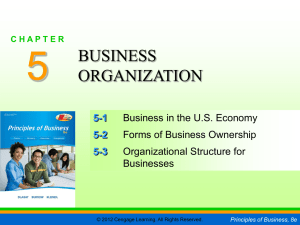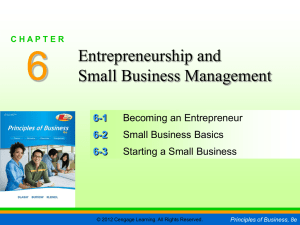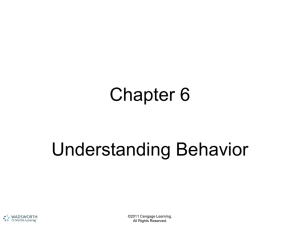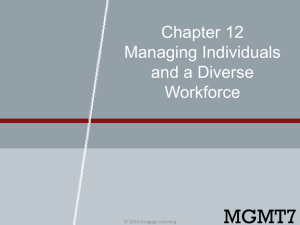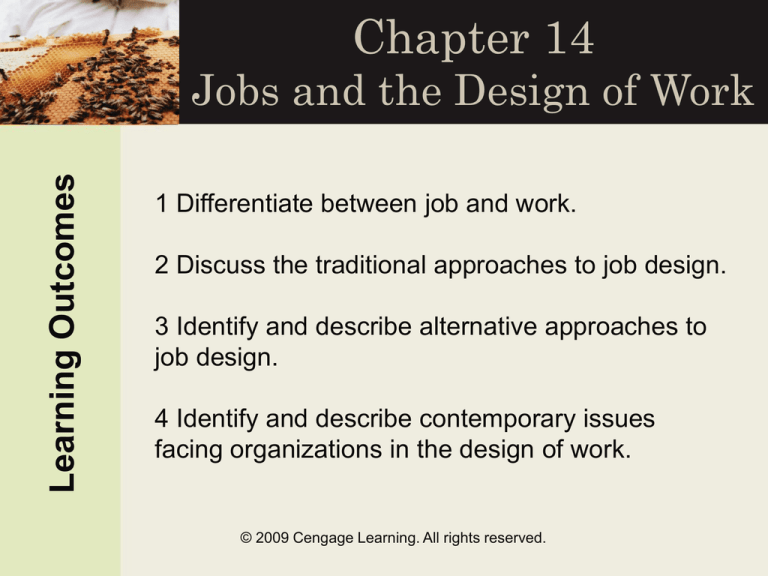
Chapter 14
Learning Outcomes
Jobs and the Design of Work
1 Differentiate between job and work.
2 Discuss the traditional approaches to job design.
3 Identify and describe alternative approaches to
job design.
4 Identify and describe contemporary issues
facing organizations in the design of work.
© 2009 Cengage Learning. All rights reserved.
1
Learning Outcome
Differentiate between job
and work.
© 2009 Cengage Learning. All rights reserved.
Job
a set of specified work and task activities
that engage an individual in an organization
© 2009 Cengage Learning. All rights reserved.
Ways of Thinking about Jobs
• Organizational position – a job in
relation to other parts of the
organization
• Career – a sequence of job
experiences over time
© 2009 Cengage Learning. All rights reserved.
Work
mental or physical activity that has productive
results
Meaning of Work – the way a person interprets and
understands the value of work as part of life
© 2009 Cengage Learning. All rights reserved.
Six
Patterns
of Work
B – provides
A – value
comes from
performance;
accountability
is important
personal
affect and identity
C – profit accrues to
others by work
performance
Amanda
F – activity constrained E –
to specific time
periods; no positive
affect through
its performance
generally
unpleasant
physically
and mentally
strenuous
activity
D – physical
activity
directed by
others and
performed
in a
workplace
2
Learning Outcome
Discuss the traditional
approaches to job design.
© 2009 Cengage Learning. All rights reserved.
Scientific
Management
Job
Characteristics
Theory
Traditional
Approaches to
Job Design
Job
Enrichment
Job Enlargement/
Job Rotation
Scientific Management-Miles
Emphasizes work simplification
(standardization and the narrow, explicit
specification of task activities for workers)
- Undervalues the human capacity for
thought and ingenuity
+ Allows diverse groups to work together
+ Leads to production efficiency and higher
profits
© 2009 Cengage Learning. All rights reserved.
Job Enlargement / Rotation-Miles
Job Enlargement – a method of job design that
increases the number of activities in a job to
overcome the boredom of overspecialized
work
Job Rotation – a variation of job enlargement in
which workers are exposed to a variety of
specialized jobs over time
Cross-Training – a variation of job enlargement
in which workers are trained in different
specialized tasks or activities
© 2009 Cengage Learning. All rights reserved.
Emphasis is on recognition,
responsibility, and advancement
opportunity © 2009 Cengage Learning. All rights reserved.
JOB ENRICHMENT
Designing or redesigning jobs by
incorporating motivational factors into
them
Job Characteristics Model
a framework for understanding person–job
fit through the interaction of core job
dimensions with critical psychological
states within a person
© 2009 Cengage Learning. All rights reserved.
Job Diagnostic Survey (JDS)
the survey instrument designed to
measure the elements in the Job
Characteristics Model
© 2009 Cengage Learning. All rights reserved.
Job Characteristics ModelKaylee
Core
job
dimensions
Skill variety
Task identity
Task significance
Autonomy
Feedback
Critical
psychological
states
Experienced work’s
meaningfulness
Experienced
responsibility
for work’s outcomes
Knowledge of work
activities’ results
Employee
growth, need,
strength
Personal and
work
outcomes
High internal
work motivation
High-quality
work performance
High satisfaction
with the work
Low absenteeism
and turnover
J.R. Hackman and G.R. Oldham, “The Relationship Among Core Job Dimensions, the
Critical Psychological States, and On-the-Job Outcomes,” The Job Diagnostic Survey: An
Instrument for the Diagnosis of Jobs and the Evaluation of Job Redesign Projects, 1974.
Reprinted by permission of Greg R. Oldham.
Five Core Job Characteristics-Kaylee
Motivating Potential Score
Skill + Task + Task
variety identity significance
MPS =
3
x [Autonomy] x [Feedback]
3
Learning Outcome
Identify and describe
alternative approaches to
job design.
© 2009 Cengage Learning. All rights reserved.
Social Information
Processing (SIP) ModelHillary
a model that suggests that the important job
factors depend in part on what others tell a
person about the job
© 2009 Cengage Learning. All rights reserved.
Premises of (SIP) ModelHillary
Four premises
1) people provide cues to understanding the
work environment
2) people help us judge our jobs
3) people tell us how they see our jobs
4) people’s positive and negative feedback
help us understand our feelings about our
jobs
© 2009 Cengage Learning. All rights reserved.
Interdisciplinary ApproachKyle M
Motivational
Mechanistic
Biological
Perceptual/
motor
Ergonomics – The science of adapting work and working
conditions to the employee or worker
© 2009 Cengage Learning. All rights reserved.
Outcomes of Various Job Design Approaches-Kyle
M
Decreased training time
Higher utilization levels
Lower error likelihood
Less mental overload
Lower stress levels
Higher job satisfaction
Higher motivation
Greater job involvement
Higher job performance
Lower absenteeism
+
+
Mechanistic
Approach
Motivational
Approach
Lower job satisfaction
Lower motivation
Higher absenteeism
Increased training time
Lower personnel utilization
Greater chance of errors
Greater chance of mental
overload and stress
-
-
Outcomes of Various Job Design Approaches-Kyle
M
Less physical effort
Less physical fatigue
Fewer health complaints
Fewer medical incidents
Lower absenteeism
Higher job satisfaction
Lower error likelihood
Lower accident likelihood
Less mental stress
Decreased training time
Higher utilization levels
+
+
Biological
Approach
-
Higher financial costs
because of changes
in equipment or
job environment
Perceptual Motor
Approach
-
Lower job satisfaction
Lower motivation
International Perspectives on
the Design of Work
The Japanese Approach
– Emphasizes strategic level
– Encourages collective and
cooperative working
arrangements
lean production
production
– Emphasizes lean
© 2009 Cengage Learning. All rights reserved.
Lean Production
Using committed employees with everexpanding responsibilities to achieve zero
waste, 100% good product, delivered on time,
every time
© 2009 Cengage Learning. All rights reserved.
Beyond the Book:
Growth in the Champagne Industry
Strict laws regulate the output of France’s grape
vineyards, leaving a limited supply to fill the demand for
champagne
Industry juggernaut LVMH Moët Hennessy Louis
Vuitton stays ahead of the competition by
assiduously pursuing grape farmers’ favor
LVMH point man Jacques Péters:
"The objective is to develop loyalty"
© 2009 Cengage Learning. All rights reserved.
International Perspectives on the
Design of Work
The German Approach
– Previously, Technocentric –
placing technology and
engineering at the center of job
design decisions
– Recently, Anthropocentric –
placing human considerations at
the center of job design decisions
International Perspectives on the
Design of Work
The Scandinavian Approach
– encourages high degrees of worker
control
– encourages good social support
systems for workers
© 2009 Cengage Learning. All rights reserved.
Scientific
approaches of
labor sciences
View
from
natural
science
Primarily
oriented
to
individuals
View
from
cultural
studies
Primarily
oriented
to groups
Levels of
evaluation
of human
work
Problem areas and
assignment to
disciplines
Technical,
Practicability anthropometric, and
psychophysical problems
Endurability Technical, physiological,
and medical problems
Economical and
Acceptability
sociological problems
Satisfaction
Sociopsychological and
economic problems
H. Luczak, “’Good Work’ Design: An Ergonomic, Industrial Engineering Perspective,” in J.C. Quick,
L.R. Murphy, and J. J. Hurrell, eds. Stress and Well-Being at Work (Washington, D.C.): American
Psychological Association. Reprinted by permission.
Work Design and Well-Being:
To increase control in work
organizations-Kellie
• Give workers the opportunity to control
aspects of work and workplace
• Design machines and tasks with optimal
response times and/or ranges
• Implement performance-monitoring
systems as source of worker feedback
© 2009 Cengage Learning. All rights reserved.
Work Design and Well-Being:
To reduce uncertainty-Kellie
• Provide employees with timely and
complete work information needed
• Make clear and unambiguous work
assignments
• Improve communication at shift change
time
• Increase employee access to
information sources
© 2009 Cengage Learning. All rights reserved.
Work Design and Well-Being:
To manage conflict-Kellie
• Use participative decision making
to reduce conflict
• Use supportive supervisory styles
to resolve conflict
• Provide sufficient resource
availability to meet work demands,
thus preventing conflict
© 2009 Cengage Learning. All rights reserved.
4
Learning Outcome
Identify and describe
contemporary issues
facing organizations in
the design of work.
© 2009 Cengage Learning. All rights reserved.
Emerging Issues in Design of WorkXiaohan
• Telecommuting –
employees work at
home or in other
locations
geographically
separate from their
company’s main
location
• Alternative work
patterns:
Flextime – an alternative work pattern that enables employees to set their
own daily work schedules
Job Sharing – an alternative work pattern in which there is more than one
person occupying a single job
© 2009 Cengage Learning. All rights reserved.
Beyond the Book:
The Work Design Questionnaire
The Work Design Questionnaire was created
to fill gaps in existing work-characteristics
assessments and integrate their data
Results from the questionnaire found that both
motivational work characteristics and social
support played a strong role in predicting job
satisfaction
© 2009 Cengage Learning. All rights reserved.
Performance Consequences of Role Behaviors-Krystle
Role
Characteristics
Standard
Role
Behavior
Extra Role
Behavior
Counter Role
Behavior
Correctly Specified Role
Ordinary good
performance
Excellent performance
(organizational
citizenship and prosocial
behavior)
Poor performance
(deviance, dissent, and
grievance)
Incorrectly Specified
Role
Poor performance
Very poor
performance
(bureaucratic zeal)
Excellent performance
(task revision and
redirection, role
innovation)
Counter-Role Behavior – deviant behavior in either a correctly or
incorrectly defined job or role
Republished with permission of Academy of Management, PO Box 3020, Briar Cliff Manor, NY 10510-8020. “Task Revision:
A Neglected Form of Work Performance,” (Table), R. M. Straw & R. D. Boettger, Academy of Management Journal, 1990, Vol. 33.
Reproduced by permission of the publisher via Copyright Clearance Center, Inc.0
Emerging Issues in Design of WorkRich
• Technology at work
– Virtual Office – a mobile platform of
computer, telecommunication, and
information technology and services
– Technostress – the stress cause by new
and advancing technologies in the
workplace
• Task Revision – the modification of
incorrectly specified roles or jobs
• Skill development
© 2009 Cengage Learning. All rights reserved.
The Distinguishing Feature
of Job Design in the FutureRich
© 2009 Cengage Learning. All rights reserved.



